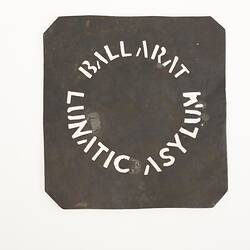Summary
Overview of migration and metal illness in Victoria focusing on the late 19th and early 20th centuries.
Migrating from one country to another is inevitably a major life-changing event and, depending upon the circumstances, it can also be a traumatic event. This raises questions about the relationship between migration and mental health: can migration actually damage mental health or might it in fact enhance it? There are no easy answers to such questions as multiple factors are involved and multiple outcomes are possible. The reasons why people chose to leave their places of birth are obviously important, as are their experiences when travelling to their destinations, and especially how they fare when settling in their new homelands. Migration is risk-taking behaviour and therefore it seldom occurs without a measure of stress and anxiety. Many immigrants survive their transition essentially unscathed and ultimately view the risk they have taken as justified; but for others the outcome proves not to have been justified by the risk and migration becomes a traumatic experience.
Over the last 150 years Australia has ranked fourth, behind the USA, Canada and Brazil, on the list of the countries of the world receiving the most immigrants in proportion to their populations. Victoria, both as a colony before 1901 and as a state afterwards, has exhibited a similar demographic pattern. For example, in 1861, according to census figures, 71% of Victoria's population had been born outside Australia, mainly in England, Ireland and Scotland. The proportion of immigrants in the population fell sharply after the 1870s: it was down to 21% in 1901, 13% in 1933 and 9% in 1947. But by 1981, in the wake of post-1945 assisted migration schemes, it had climbed back to 23%, at which level it remained in 2001 before rising again to 27% in 2011. Therefore, throughout much of Victoria's history, immigrants have formed a significant proportion of the population. But, during the late 19th and early 20th centuries, they formed an even larger proportion of the population of Victoria's lunatic asylums and mental hospitals.
In 1889 a major medical congress was held in Melbourne for the first time and, in the section of the meeting devoted to psychology, important papers were delivered on the mental health of the colonies. One of these showed that in 1887 only 23% of the inmates of Australia's 18 public lunatic asylums were Australian-born, the remaining 77% being immigrants. The largest group in the asylum population came from Ireland (27%), followed by England and Wales (23%) and then Scotland (6%), with smaller numbers coming especially from Germany and China. The figure of 77% was well in excess of the percentage of immigrants in the general Australian population at the time, which was about 33%. In their papers the medical experts struggled to explain why such a high proportion of the colonial mentally ill were immigrants.
This was an era when medicine, including psychology, was very much influenced by what is now called 'scientific racism'. One of the most important papers delivered at the congress was entitled 'Race and Insanity'. It argued that different 'races', under which heading it listed Australians, English, Irish, French, Americans and also Aborigines and Chinese, inherited different mental characteristics and thus suffered from different types of insanity; indeed, some 'races' were more prone to insanity than others. The Irish, for example, were identified as having less 'will power' and being more 'demonstrative' than other 'races'. The Australian-born, on the other hand, had benefitted from what was called 'hybridity': that is, as many Australians had a mixture of English, Scots and Irish ancestry, the undesirable mental characteristics of the Irish had been diluted.
But external factors were also judged to be important. The Australian-born suffered much lower rates of mental illness, it was argued, partly due also to the fact that they had been brought up in a good climate, with plenty of opportunities for physical exercise. Australians were more 'self reliant and self confident' than other 'races', and these factors also contributed to their superior mental health. Some experts used the apparently high rates of mental illness among immigrants to argue for more rigorous government control of immigration, suggesting that families and authorities overseas deliberately sought to rid themselves of mad people by encouraging them to emigrate.
Papers at the 1889 congress also investigated the types of mental illness suffered by asylum inmates and concluded that immigrants were especially prone to 'delusional insanity' or 'paranoia': that is, because they were ignorant of Australia and its customs, they were likely to become 'suspicious' and develop 'false beliefs'.
Victoria had more lunatic asylums and a larger asylum population at the end of the 19th century than any other Australian colony. In 1887 it had 6 overcrowded asylums housing some 3,300 patients, while in 1889 it was estimated that 1 in every 300 Victorians was resident in an asylum, whereas the comparable figure for New South Wales was 1 in every 377 persons. The writer of an 1880 article 'On the Prevention of Lunacy' was so alarmed by the apparent increase in insanity, he predicted that, if present trends continued, by 2043 Victoria would have a population of 60 million - all of them 'lunatics'.
This perceived increase in insanity led some experts to argue that the 'gold fever' of the 1850s had had a detrimental effect on the colony's mental health. The majority of the Victoria's population was male, and men predominated even more strongly among immigrant groups and also among the asylum population; and most men in the two latter groups were unmarried. The two asylums opened in 1867 at Beechworth and Ararat to serve the goldfields housed largely unmarried male populations, many undoubtedly ex-diggers. Asylum casebooks often recorded male patients being admitted due to 'disappointment' and 'isolation'. Because there were far fewer women than men among most immigrant groups, this meant that while nearly all female immigrants married, many males did not. During and after the gold rushes some male immigrants developed a semi-nomadic lifestyle: they moved from diggings to diggings in Victoria or travelled further afield as new gold rushes occurred in Queensland and Western Australia and also in New Zealand; others became itinerant bush workers and swagmen. But 'disappointment', in terms of failing to fulfil their dreams of wealth, and 'isolation', in terms of having no family ties in Australia, obviously took a heavy toll over the years among the gold-rush male immigrant generation and as a result significant numbers of them ended their days in Victoria's lunatic asylums.
Today historians reject arguments about mental health based upon 'race', however they recognize the significance of ethnic, cultural, social, economic and gender differences. They also note that at least some of the apparent over-representation of immigrants in late 19th-century asylums is misleading, being the result of structural differences in populations. The age profiles of the immigrant and Australian-born populations were very different: immigrants were overwhelming adult, while children under 15 years of age made up a large proportion of the Australian-born population. In Victoria between 1861 and 1901, for example, around 33% of the general population was under 15. The fact that children were seldom committed to asylums ensured that per capita admission rates would inevitably be lower among the Australian-born population than among the immigrant population. However, there were other more concrete factors operating to the disadvantage of immigrants as well.
Asylums and mental hospitals were public institutions catering in particular for those who couldn't afford private care. Immigrants tended to be disproportionately represented among the working class and the poor and, as a consequence, their families were more likely to avail of public medical care when a member became either physically or mentally ill. In addition to poverty, other important factors were prejudice and discrimination. As we've seen, experts, most of whom were doctors running asylums, believed that certain 'races', like the Irish, were more prone to insanity. Medical views such of these inevitably biased those responsible for admitting people to lunatic asylums and for treating them in such institutions. Thus, while anti-social behaviour among Australian-born men might have seen them confined in a prison, among Irish-born men it might well have seen them committed to a lunatic asylum.
Other groups subject to racialized medical views about mental health included Chinese immigrants. In 1861 there were nearly 25,000 Chinese in Victoria, virtually all of them single men - there were only 8 Chinese women in the whole colony. Most lived in mining areas, where they composed around 15% of the male population. By 1901, after Chinese immigration had been restricted and many Chinese had willingly or unwillingly returned home, their numbers had plunged to a little over 6,000, including by then 600 Chinese women. From the 1850s onwards some Chinese men found their way into Victoria's asylums. In their case language and cultural differences were important issues. Medical and nursing staff, most from British and Australian backgrounds, often could not communicate with Chinese patients due to language differences. And, even with the assistance of interpreters, Western doctors had little chance of fully understanding what afflicted a Chinese patient and so tended to fall back on unflattering racial stereotypes for a diagnosis. Similar problems occurred with Jewish patients, many of whom came from Germany, Poland and Russia. Victoria was home to Australia's largest Jewish community in the late 19th century, ranging from around 3,000 people in 1861 up to around 6,000 by 1901. Again language was often a problem, but also dietary practices, and again racial stereotypes were freely employed by doctors in order to account for patients' disorders.
Immigration to Australia and also Victoria declined significantly during the depression of the 1890s, during World War I and again during the depression of the 1930s. Indeed, between 1891 and 1905 Victoria experienced net outward migration, with 170,000 more people leaving than arriving; and during the whole period from 1901 to 1940 the state's net immigration gain was only 91,000. As a result, after 1900, the numbers of immigrants in the state's mental hospitals declined quickly to become a decided minority. Yet migration continued to be a traumatic experience for some, breeding disappointment and isolation, while poverty and prejudice remained significant factors in determining why immigrants were committed to such hospitals and how they were treated in them.
More Information
-
Keywords
Mental Health, immigration, Irish Immigration, English Immigration, Scottish Immigration, Chinese Immigration, Mental Health Institutions, Psychiatric Institutions
-
Authors
-
Article types

